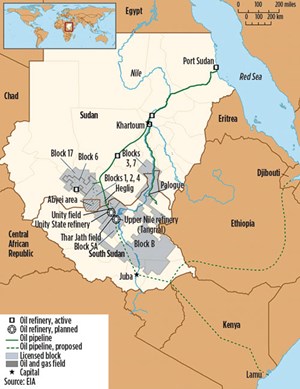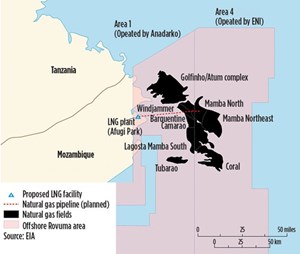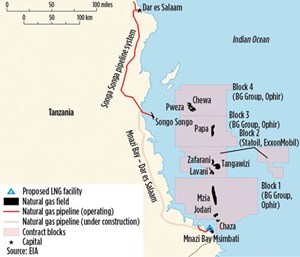Regional report: East Africa

East Africa has received attention from international oil companies as an emerging region for petroleum exploration, with relatively recent oil discoveries in Uganda and Kenya, and gas finds of as much as 400 Tcf offshore Mozambique and Tanzania. East African countries are extremely poor, and they have large populations. According to the U.S. CIA’s World Fact Book, Uganda, Kenya, Tanzania and Mozambique are home to roughly 154 million people, 40% of whom are under the age of 14, and 80% of whom depend on agriculture for their living. The average per capita GDP of these countries is just over $1,500 per year.
Local East African communities are waiting impatiently for the economic benefits that oil and gas exploration can bring, including jobs, tax revenues and investment in infrastructure. At the same time, community leaders and governmental officials want to avoid the “resource curse” that has afflicted other poor countries, whose sudden wealth from extractive industries created profits for foreign companies, widespread corruption, and little benefit for the people of the host nation. Development of gold and copper resources in East Africa has done little to lift these countries from poverty.
The local governments are drafting legal frameworks to govern oil and gas leasing and development, but they lack the resources to monitor activities, enforce the laws, and assess and collect taxes. Experts at a recent conference, sponsored by the Brookings Institute and Oxfam, expressed concerns about risks to the environment, land grabs by elites where no legal deeds exist, and the potential for economic colonialism by foreign governments and multinational corporations. Uncertain governance and regulation also increase risks for operators seeking to invest in developing East African oil and gas reserves. Still, the prospects for East Africa as an oil- and gas-producing region remain high, and operators like Anadarko, BG, Statoil, Total, Tullow, CNOOC and CNPC have acquired sizeable leases, and are planning field development, infrastructure projects and LNG export facilities.
SUDAN AND SOUTH SUDAN

Although not typically mentioned as an East African exploration hot spot, the U.S. Energy Information Administration (EIA) points out that most of the oil production in the 21 countries of the region comes from Sudan and South Sudan, Fig. 1. Production from mature fields along the border of the two countries, in the Mugland and Melut basins, has declined from 490,000 bopd in 2010 to 260,000 bopd in 2014. Conflict that led to the independence of South Sudan; disruptions caused by disputes between the two countries; and attacks by armed rebels have hindered production and field maintenance. South Sudan’s oil (150,000 bopd in 2014) has to travel via pipeline across Sudan to a terminal near Port Sudan on the Red Sea. When it achieved independence, South Sudan agreed to pay Sudan $25/bbl in royalties and transportation fees for its low-quality (and discounted) crude traveling through the pipeline. Thus, the steep decline in Brent prices has impacted the country’s revenues significantly.
The Sudanese fields also have natural gas reserves totaling 3 Tcf, but without gas pipelines; produced gas is reinjected or flared.
Foreign operators—including China’s CNPC, India’s ONGC, and Malaysia’s Petronas—together hold more than 80% of the shares in four of the five operating companies in Sudan and South Sudan. CNPC signed an agreement in December 2014 to provide investment and technical assistance, to increase production from South Sudan’s fields. With renewed attacks by rebels in early 2015, China said it would send a battalion of 700 troops to join a UN peacekeeping force and protect its oilfield assets.
MOZAMBIQUE

With recent offshore discoveries in the Rovuma basin, Fig. 2, Mozambique’s natural gas reserves, totaling more than 100 Tcf, place the country 14th in the world for proved gas reserves, and third in Africa after Nigeria and Algeria. From 2010 to 2012, Anadarko found an estimated 50–70 Tcf of recoverable reserves, with 25 successful wells in the Prosperidade, Golfihno/Atum and Tubarao Tigre complexes. Eni estimates that its discoveries from four wells in the Mamba complex, and three wells at the Coral site, hold 75 Tcf of gas-in-place.
In 2012, natural gas production in Mozambique was a modest 154 Bcf per year, with 127 Bcf being exported to South Africa via pipeline, and the balance being consumed domestically. Mozambique has no crude oil production.
Anadarko and Eni have agreed to unitize their adjacent Prosperidade and Mamba fields to comply with Mozambican law (which also mandates 40% participation by the country’s national oil company, Empresa Nacional de Hidrocarbonetos, ENH). Before production can take place, onshore infrastructure will be built in the coastal village of Palma.
The two international oil companies have begun initial development of two 240-Bcf/year LNG trains near Afungi Park, where Anadarko has started to instruct local workers. This $50-billion facility is now expected to begin exports in 2018. Anadarko has announced a preliminary agreement to sell 160 Bcf/year from the first train to an Asian buyer. Eni is evaluating the feasibility of building a 120-Bcf floating LNG facility to handle production from fields not covered by the unitization agreement.
Mozambique is one of the world’s poorest countries. About 40% of the country’s $4.8-billion annual budget comes from foreign aid, largely from South Africa. The government has received more than $1 billion in taxes and licenses since 2010, and the natural gas industry is expected to contribute $115 billion by 2040. Critics have cautioned that early contracts awarded by ENH for infrastructure and logistics have been less than transparent. The influx of huge amounts of cash could create opportunities for cronyism and graft, they point out.
Mozambique plans to hold its fifth upstream licensing round in 2015. The lease auction will include 76,000 km2 in 15 blocks of the deepwater Rovuma, Zambezi, Beira High and Mozambique basins. Mozambique also has 25 billion short tons of coal reserves, which are attracting foreign investment, but will require improved infrastructure before exports can take place.
TANZANIA
Tanzania also anticipates large economic benefits from recent offshore gas discoveries. While its current 33-Bcf/year of gas production is consumed domestically, discoveries since 2010 of 25–53 Tcf in Tanzania’s portion of the Rovuma basin give it enough reserves to eventually make the country an LNG exporter.

Tanzania’s gas production comes from Songo Songo and the Mnazi Bay concession in the southeast, and it is transported 200 km by pipeline to the capital, Dar es Salaam, Fig. 3. The gas is used to power local factories, and the government has launched a program that aims to supply CNG for 30,000 households and 8,000 cars by the end of 2015.
Since 2010, BG Group and Statoil have had a 100% success rate on 21 exploration and appraisal wells off Tanzania. BG group, along with partner Ophir Energy, reported discoveries of 15 Tcf in deep water off Tanzania, with nine consecutive discoveries and five appraisal wells, including the Mzia, Jodari and Chaza finds in Block 1, the Papa discovery in Block 3, and the Pweza and Kamba finds in Block 4. BG has conducted 13,000 km2 of 3D seismic surveys and established the Mtwara Port shore base, for which 70% of equipment and supplies are furnished locally.
Statoil, with partner Exxon Mobil, has made seven discoveries in Block 2, including “high impact” gas finds in Zafarani-1, Lavani-1, Tangawizi-1, Mronge-1 and Piri-1, as well as discoveries at Lavani-2 and Giligiliani-1. Natural gas was found in Upper and Lower Cretaceous sandstones, in both the eastern and western sections of the block. Statoil is drilling another exploration well in the Kungamanga prospect to evaluate the central portion.
In April 2014, the partners for all four blocks agreed to collaborate on development of a potential $30-billion, two-train, joint LNG project, with BG Group as the lead developer. The partners signed a Memorandum of Understanding with the Tanzanian government, selecting the site for the LNG plant, and deciding how any resettlement of residents would be managed. Exports could begin in 2022 or 2023.
In the absence of comprehensive oil and gas legislation, E&P activity is governed by 26 Production Sharing Agreements (PSAs) signed with various companies since 2007. Specific terms of these PSAs have not yet been made public, but details of a Statoil PSA raised concerns that the government might have left money on the table. Two top officials of the Tanzania Petroleum Development Company (TDPC) were arrested briefly in December 2014 for not complying with a parliamentary order to release all of the PSAs to the public by a November deadline.
A new PSA framework, published in November 2014, requires signing and production bonus payments and increased royalty rates, while also clarifying cost recovery rules and capital gains taxation. Some industry analysts believe these terms will discourage investment in an area where each deepwater well costs $60–100 million, and LNG export facilities are only in the planning phase. The government expects to pass legislation in 2015, formulating the regulatory framework and enabling further foreign investment.
Tanzania held its fourth offshore licensing round from October 2013 to June 2014, and received bids for four of eight blocks. Bids were received from Exxon Mobil, Statoil, Gazprom and CNOOC, as well as Mubadala and Ras Kaimah Gas LLC from the U.A.E. Bids were still being evaluated at the end of 2014.
UGANDA
Since 2006, international oil companies have discovered 21 oil and gas fields in Uganda, all in the Lake Albert Rift basin of the northwestern corner of the country, near the border with the Democratic Republic of the Congo. Estimated recoverable oil reserves are 1.7 Bbbl.
UK-based Tullow oil has been the most active explorer in Uganda to date, with interests in four blocks. Heritage Oil & Gas made the first Ugandan discovery of the 21st century, Mputa-1, in 2006, and Tullow purchased its interests in 2010. Since then, more than 70 wells have been drilled in the country.
In March 2011, Tullow sold two-thirds of its interest in the country, forming an equal-ownership joint venture with Total and CNOOC. Total retains one-third ownership in each of four licenses in the basin and operates Exploration Area-2. Total operates Exploration Area-1, and CNOOC operates the new Kanywataba and Kingfisher licenses in the former Exploration Area-3A. Production from these four licenses is expected to reach 200,000 to 230,000 bopd by 2020.
The three-company partnership has prepared a Lake Albert basin-wide development plan, which was approved by the government of Uganda in February 2014. The plan includes a crude export pipeline from the basin to the Kenyan coast, a modular refinery with an initial capacity of 30,000 bopd, and the use of petroleum to generate electricity.
The Lake Albert rift basin is an environmentally sensitive area that includes Murchison Falls National Park and is home to threatened wildlife like gorillas, crocodiles, elephants and rare varieties of giraffes. The lake feeds into the White Nile River, so oil spills could impact Sudan and Egypt. To reduce impact, Total has used cable-free data acquisition to conduct 3D seismic surveys, and has drilled the first horizontal well in the country. Tullow has contributed to educational and health initiatives in local communities, and CNOOC has built roads. The Ugandan government has carefully reviewed applications for production licenses. This approach has delayed revenue from production, but it is expected to minimize adverse impacts on residents and the environment.
KENYA
Until recently, Kenya had supported the East African energy industry, primarily as a transportation and refining hub. The Mombassa Port serves international trade for Kenya and land-locked Uganda, Rwanda, Burundi, Democratic Republic of the Congo, and South Sudan, handling nearly 20 million tons of cargo per year. The port has two oil terminals that can accommodate tankers up to 100,000 dwt. The outdated Mombassa refinery, which had processed crude from the U.A.E., was converted to a storage facility in 2014, and now receives refined products from the Middle East and Asia. Kenya’s product pipeline system transports petroleum products to Nairobi, other parts of Kenya, and neighboring countries. A new Mombassa-to-Nairobi pipeline is planned, and pipelines from Uganda and South Sudan to the port of Lamu are also being evaluated.
With experience in Uganda, Tullow moved across the border to northern Kenya, to explore in the South Lokichar basin, where it discovered oil in 2012. Tullow extended its search in Kenya to the North Turkana and South Kerio basins, and is in the middle of a 15-well exploration and appraisal program. Tullow estimates that it has discovered 600 MMbbl of oil to date, and plans to submit a field development plan to the Kenyan government in 2015. Tullow continues to conduct seismic activity in Kenya and Ethiopia.
Apache made a gas discovery offshore Kenya with its Mbawa-1 well. However, the U.S. firm abandoned the well, because it did not encounter commercial quantities of oil or gas.
MADAGASCAR
Madagascar Oil began producing heavy oil on a small scale from Tsimiroro field (Block 3014) in the northwestern part of the island, using the “huff and puff” cyclic steam stimulation process in 2008. Sweet, heavy oil was first discovered in Tsimiroro in 1909, but the field was not considered commercial without thermal recovery methods, and Madagascar Oil now estimates that the field contains 1.7 Bbbl of recoverable oil. In 2013-2014, the company conducted a 25-well, pilot steamflood project that increased recovery rates. Block 3014 was declared commercial in May 2014, and the company submitted a development plan to Madgascar’s Office des Mines Nationales et des Industries Strategiques (OMNIS) in October, with the ultimate goal of producing 25,000 to 50,000 bopd for generating electricity and export.
The Bemolanga bitumen deposits, thought to contain 1.2 Bboe, were considered by Madagascar Oil and Total for possible oil mining, but in 2011 the project was deemed non-commercial. Madagascar Oil continues to evaluate three other onshore license areas, which are south of Tsimimoro and Bemolanga.
OMNIS reports that EAX and Yanchang Petroleum are conducting onshore seismic exploration, and that EAX conducted a 12-well, shallow onshore drilling/coring campaign in 2014.
Sparked by gas discoveries off Tanzania and Mozambique, the waters off the west coast of Madagascar have been mapped thoroughly with 2D seismic, but heavy oil in the offshore portions of the Morondava basin to the south has proved non-commercial.
To the north, in the deepwater Ambilobe basin, Sterling Energy, with partner Pura Vida Mauritius, is planning 1,250 km2 of 3D seismic to identify drilling targets, based on leads detected in earlier 2D seismic surveys.
In the deepwater Majunga basin, Exxon Mobil, with partner Sterling Energy, will continue seismic surveying in the Ampasindava Block. Exxon Mobil plans to drill one exploration well in 2015 to reach the Sifaka prospect in the block, which could hold gross prospective oil resources of 1.2 Bbbl. ![]()

- Advancing offshore decarbonization through electrification of FPSOs (March 2024)
- What's new in production (February 2024)
- Subsea technology- Corrosion monitoring: From failure to success (February 2024)
- U.S. operators reduce activity as crude prices plunge (February 2024)
- U.S. producing gas wells increase despite low prices (February 2024)
- U.S. oil and natural gas production hits record highs (February 2024)
- Applying ultra-deep LWD resistivity technology successfully in a SAGD operation (May 2019)
- Adoption of wireless intelligent completions advances (May 2019)
- Majors double down as takeaway crunch eases (April 2019)
- What’s new in well logging and formation evaluation (April 2019)
- Qualification of a 20,000-psi subsea BOP: A collaborative approach (February 2019)
- ConocoPhillips’ Greg Leveille sees rapid trajectory of technical advancement continuing (February 2019)


